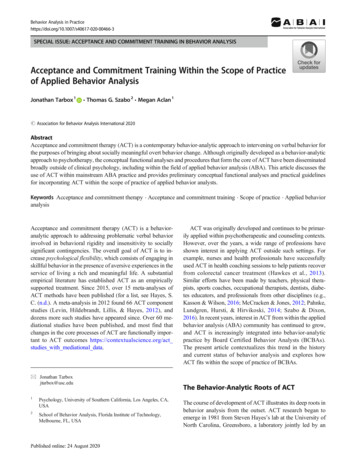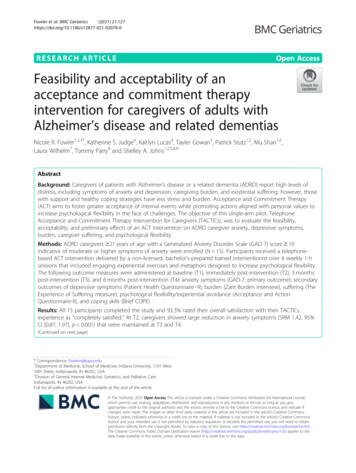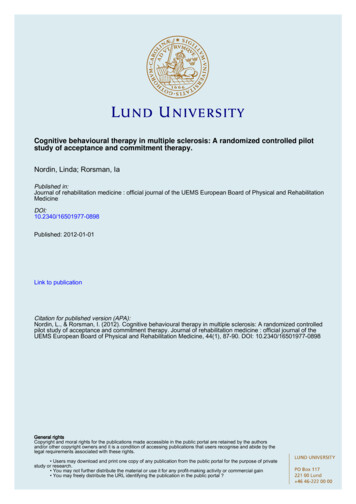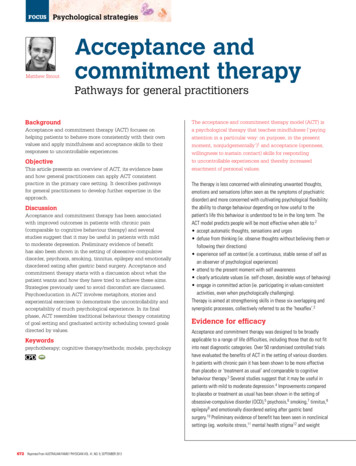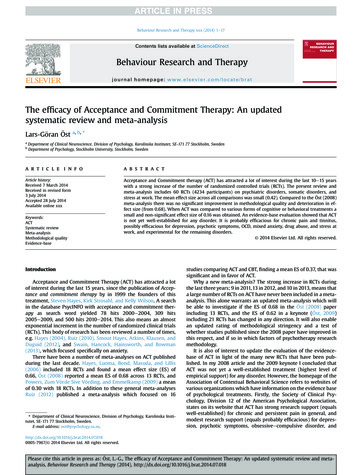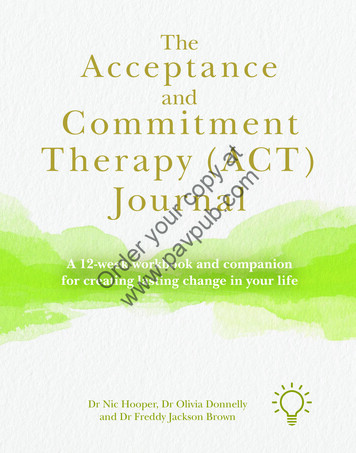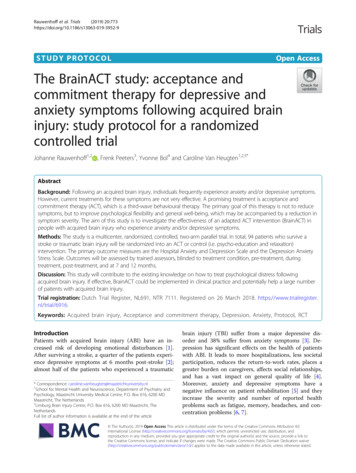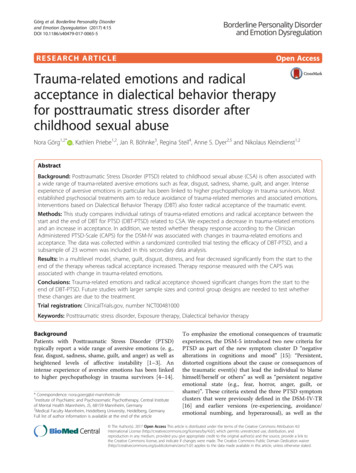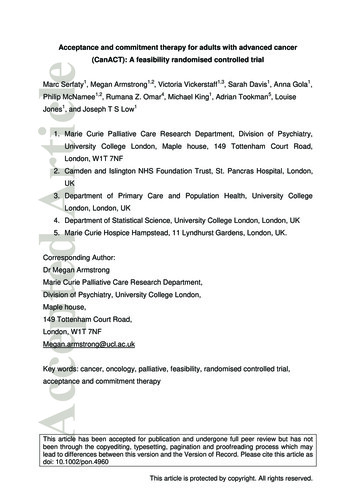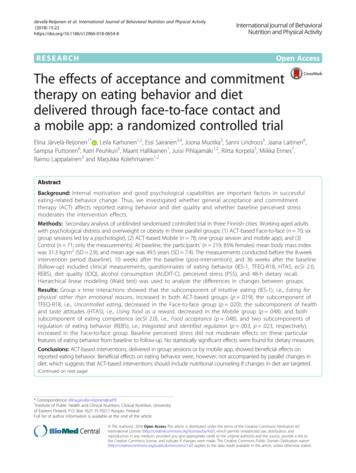
Transcription
Acceptance and Commitment Therapy for PTSDVeteran ManualRegan Settles, Ph.D.Beth Morris, Ph.D.Kristi Bratkovich, Ph.D.
AcknowledgementsPortions of this manual were adapted from or influenced by the following sources:Follette, V.M., & Pistorello, J. (2007). Finding Life Beyond Trauma: Using A cceptance andCommitment Therapy to Heal Post-Traumatic Stress and Trauma-Related Problems.Oakland, CA: New Harbinger Publications.Harris, R. (2009). A CT Made Simple: A n easy-to-read Primer on Acceptance and Commitment Therapy.Oakland, CA: New Harbinger Publications.Hayes, S. C., Strosahl, K. D., & Wilson, K. G. (1999). A cceptance and commitment therapy: an experientialapproach to behavior change. New York: Guilford Press.Hayes, S. C., & Strosahl, K. D. (Eds.). (2005). A practical guide to acceptance and commitment therapy.New York: Springer Science.Hayes, S.C., & Smith, S. (2005) Get of Y our Mind and Into your Life. Oakland, CA: New Harbinger.Juariscio, A., Shaw, J., Forman, E., Timko, C.A., Herbert, J., Butryn, M., & Lowe, M. (2010)The WE-ACT Group: Weight and Eating Applications of Acceptance-BasedTreatments. Unpublished Manual.Kabat-Zinn, J. (1994). W herever you go, there you are: Mindfulness Meditation in EverydayLife. New York: Hyperion.Stahl, B., & Goldstein, E. (2010). A Mindfulness-Based Stress Reduction Workbook. Oakland,CA: New Harbinger.Walser, R.D. & Westrup, D. (2007). A cceptance and Commitment Therapy for the Treatmentof Post Traumatic Stress Disorder and Trauma-related Problems. Oakland, CA: NewHarbinger Publications.Portions of session 10 were also adapted from sources on Dr. Russ Harris’ website:www.thehappinesstrap.comThe authors would also like to thank Chase Bailey, Ph.D. for his assistance early versions of this manual.”This work was supported by a clinical educator grant from the VA South Central Mental Illness Research,Education and Clinical Center (MIRECC)3
Group Guidelines ConfidentialityEverything you discuss in group is confidential with two exceptions: (1) If you report any plans to hurtyourself or someone else and (2) If you report any abuse. In both of these cases, group leaders are legallyrequired to break your confidentiality to protect you and/or othersWhile your group leaders are bound to confidentiality, group members are not. By participating in thisgroup, we ask you to keep this a safe space by keeping everything that your fellow group members discussprivate. RespectWe are all unique people and will have different points of view. Please respect others who think differentlythan you do. Please also respect that people process their trauma at different paces. Be on timeWe have a lot to discuss in this group! If you are more than five minutes late, please enter quietly to avoiddisruption. Please also be aware that we may not be able to catch you up on missed content. Missing sessionsIf you miss more than two weeks of the group, we will ask you to discontinue and start again during anothergroup. This is because missing more than two sessions will result in you not receiving adequate exposure tothe group content. Staying on TopicMost people have numerous problems going on in their lives. While we view all of this as important, ourfocus in this group is on posttraumatic stress symptoms. If we redirect you during group, it is not becausewhat you are saying is wrong. Instead, it is because we have limited time and want to make sure that wefocus on the purpose of the group. You may also bring something up that is on topic and important, but thatwe cannot fully address as a group. In these instances, you may asked to address the topic with an individualtherapist or group leader outside of the group session. HomeworkIf you only come to group and do nothing in between sessions, this group will have limited effectiveness.For this reason, we will be giving you weekly assignments to complete between sessions. This homeworkserves two purposes. First, it helps you apply the things you are learning in group to your specific struggles.Second, it gives you experience using the group material in the real world. If you are struggling with any ofthe assignments, please bring this up to group leaders as soon as possible so that we can help you identify andovercome barriers. Open-mindednessDuring this group we will ask you to think in new ways and at times participate in activities that seemdifferent to you. It is normal to feel confused at times or wonder if this will be helpful to you. Please keepan open mind throughout the group.4
Session 1 OverviewWhat is ACTThe overall idea of Acceptance and Commitment Therapy, orACT, is that trying to avoid the pain of PTSD comes at a cost:that cost is the ability to really engage in a life that ismeaningful to YOU. The core idea of this group is that we canlearn new ways to live with pain, while making more room forthe important things in our lives.Goals of the Group Overcome the pull to avoid your painful memories and anxiety Learn skills to help you live a life that matters to you, despite the presence of PTSD Learn skills to relate to your trauma a new way, so it has less power over your actionsPain of Presence and AbsencePain is inevitable and unavoidable. We can think of the inevitablepresence of pain in life as “clean pain.” When we put a lot offocus and effort into avoiding or getting rid of the pain ofpresence, we can miss out on important things in life. This is thepain of absence, which can be thought of as “dirty pain” oravoidable pain. By reducing the pain of absence, ACT helps usreconnect with what we find most meaningful and important.Tug-of-War Monster Activity: My Take Home Points5
Session 1: The Pain of PTSD WorksheetColumn 1:What are the sources of myPTSD Pain? (“clean pain”)Column 2:How have I have tried to getrid of PTSD pain?Common sources of PTSD Pain: Feelings (e.g., anxiety, anger) Sensations (e.g., shaky, tense) Urges (e.g., to leave a crowdedplace, to use substances) Thoughts (e.g., about the trauma) Memories (e.g., of what happened) Images/SoundsColumn 3:What am I missing out onwhen I do that? How doesthis interfere with the life Iwant? (“dirty pain”)Common ways we try to get rid of PTSD Pain: Distraction (e.g., videogames, working overtime) Withdrawing or giving up (e.g., isolating, stoppingactivities) Thinking (e.g., ruminating, dwelling on, fantasizing,blaming) Numbing (e.g., with substances, self-harm, recklessness) Controlling (e.g., only sitting in a particular place,always being the driver) Avoiding people, places, things Constantly checking for danger6
Session 1 Home work Finish completing your Pain of PTSD worksheet. Considerbigger sources of pain that you struggle with as well as dayto day things that come up for you. See if you can identifyany patterns in how you tend to try to get rid of pain/anxiety,and assess the potential personal cost of those efforts. Complete the PTSD Beliefs and Behaviors worksheet. Usethe completed example as a guide.7
Session 1 Homework: PTSD Beliefs and Behaviors WorksheetDirections: PTSD can impact how we think about things (our beliefs) and what we do (ourbehaviors). Consider how your PTSD has affected your beliefs about yourself, other people, and the worldin the following areas. Answer the following questions by writing how PTSD has affected your beliefs ineach area. Next, write how this belief has affected your behavior (i.e., led you to do something differently).Write about the impact of these behaviors on you living the life you want to live. Be as specific as possible.Use the completed example on the following page as a guide.1. How has PTSD affected your sense of safety?2. How has PTSD affected your ability to be intimate with others or comfortable with yourself?3. How has PTSD affected your ability to trust yourself or others?4.How has PTSD affected your confidence in yourself and in other people?Questions to help you identify ways that your beliefs may have impacted your beliefs and behaviors:Are there places you won’t go or things you won’t do? What are you afraid will happen in those places?Are there any ways in which you tend to “check out,” give up, or numb yourself?Do you try to control scary situations? For example, do you scan dangerous environments?Check your doors at night a lot? Ask family to call in frequently? Do you look for signs of being hurt byothers? Do you isolate? Are there ways you try to punish yourself?8
Session 1 Homework: PTSD Beliefs and Behaviors WorksheetCompleted example1. How has PTSD affected your sense of safety?I believe I must always be on guard. This leads to me checking my doors a lot at night and constantlyscanning my environment. This leaves me feeling safer but I also can’t always enjoy myself when I am outbecause I am on guard.I am afraid that if I go out in a crowd, I will get anxious and lose control. This keeps me from going toimportant events with my family. It also decreases my confidence in myself.I am scared that my daughter will get hurt. To manage my fear, I make her check in with me constantly.This annoys her and causes tension in our relationship. It also makes me constantly anxious when she isgone.2. How has PTSD affected your ability to be intimate with others or comfortable with yourself?I don’t believe that civilians can understand me. I cope by not spending time with them. This has hurt myrelationship with my family and left me with few friends.I don’t want to get close to people because I’m afraid they might get hurt. I cope by isolating. This has leftme feeling lonely.3. How has PTSD affected your ability to trust yourself or others?I am afraid that if I express my emotions, I will lose control. This keeps me bottling a lot of things inside.I don’t think I can trust anyone. I keep everyone distant and I don’t have many relationships.4. How has PTSD affected your confidence in yourself and in other people?I believe that I am damaged and unlovable because of my trauma. This leads me to push people awaybefore they get too close. Again, I stay emotionally safe but I am lonely.I believe that I don’t deserve to be happy because other people have died. I cope with this by not lettingmyself enjoy any good things in life. I am miserable because of it.I believe that other people are always working against me. I cope with this by keeping them at a distance.This has made me feel lonely and angry a lot.9
Session 2 OverviewReminder:It is a natural part of being human to try andavoid pain. With PTSD, the pull to try andavoid painful or scary memories, thoughts,emotions, and physical sensations is strong.One of our goals in this group is to help youovercome the pull of avoidance.Joe the Annoying Uncle: My Take Home Points:10
Session 2 OverviewWillingness Willingness means “making room” for all the negative feelings, thoughts, physical sensations, memories,etc. associated with your trauma so that you can free up your energy to focus on what matters to you. Willingness is about living with the AND instead of the BUT. (e.g., “ I want to go out with my familyAND I’m anxious about it” instead of “I want to go out with my family BUT I’m anxious.”). This attitudeallows you to carry the painful things AND still pursue the life you want. Willingness isn’t a one-time action. It is a constant choice. Willingness doesn’t get rid of your symptoms. Getting rid of your symptoms may be a nice side-effect,but you have to practice willingness regardless of whether you get symptom relief.Mindfulness Being aware of your present environment, thoughts, feelings, emotions, and physical sensations,rather than thinking about the past or worrying about the future. Goals of mindfulness: To help you see what goes on inside yourself in order to counter the emotional disconnect/numbing and hypervigilance that pulls you from the present moment To serve as a “systems check” so you can engage in healthy action To create some space between what you experience and how you react To increase your ability to accept painful internal experiences and increase your pleasantexperiencesI feel anxious.The sun iswarm on myface.11
Session 2 Home work Practice mindfulness daily using the Be Where You Areexercise in your appendix as a guide. Aim for at least 5-10minutes and record you experience in your mindfulness log.Remember, whatever comes up is ok! There is no right orwrong way to be mindful. Complete the PTSD Beliefs and Behaviors Worksheet if youdid not do so last week. Complete the Willingness Assessment.12
Session 2 Homework: Willingness AssessmentLook over your PTSD Belief and Behaviors worksheet from last week. Right now in this moment, howwilling are you to experience the fears, images, and emotions you identified on your worksheet?My Rating: . (0 completely unwilling, 10 completely willing)Right now, how willing are you to change some of the behaviors you have been using to cope?My Rating: . (0 completely unwilling, 10 completely willing)How might your life look different if you were to choose a willing stance more frequently?What will life look like if you consistently choose unwillingness?13
Session 2 Homework: Mindfulness LogMindfulness SkillTime spent practicingObservationsPracticed14
Session 3 OverviewWhat is Fusion?Fusion: Believing that a thought is true and importantSaliva Exercise: My Take Home PointsWhat is Defusion?Defusion: recognizing a thought for what it is - sounds, words, stories, bitsof language Not believing, following, or attending to unhelpful thoughts.Instead recognizing that thoughts may or may not be true. Whether they aretrue or not is not what matters. What matters is whether they are helpful.Hands as Thoughts Exercise: My Take Home PointsDefusion PracticeMy Practice Thought:Defusion exercises practiced in group:15
Session 3 Home work Practice Defusion. Take the list of each difficult thought youidentified on your PTSD Beliefs and Behaviors Worksheet.Practice using any combination of defusion strategies on atleast one thought per day. You can also continue to practicewith the thought you used in group today. There is a list ofextra defusion exercises you can try after the mindfulnesslog. Record your experience below. Practice the Mindful Check-in at least once per day. Aim for5-10 minutes. Record your experience in your mindfulnesslog. You can find a script for the check-in in your appendixof mindfulness exercises.16
Session 3 Homework: Mindfulness LogMindfulness SkillTime spent practicingObservationsPracticed17
SESSION 3: Defusion StrategiesA Beautiful MindSee if you can picture your negative chatter as differentpeople that follow you everywhere, you see andacknowledge they are there AND need to not talk to, befriends with, or fight againstPop-Up MindImagine that your thoughts, feelings, and bodily sensationsare like Internet pop-up ads that just keep popping up whenyou least want them to, and which you can simply let pop.Passengers on a Bus Imagine that your difficult thoughts and experiences arepassengers on your bus, folks that may be scary, but whoneed not leave the bus to move.Gollum MindImagine that your mind is like Gollum and tries to trickyou sometimes just as Gollum did with Frodo by saying hecould not trust his friends or who craves something that isnot good for you.Thoughts are notCausesAsk yourself “could I still have this uncomfortablethought, feeling, or memory and still do (insert value basedgoal here)?Waves in the Ocean This is good for impulses and urges. When experiencingthe urge (to avoid for example), picture it as a wavecoming into the shore, building gradually, peaking, andthen subsiding. Be the sand that receives it without havingto do anything but just notice it coming and goingThink One Thing,Do AnotherTry to say or think that you can’t do something while doingit. “I really can’t go to the gym today” while lacing up yourshows, opening the car door (“I really can’t”), getting in(“Maybe tomorrow”), and getting to the gym (“I’m waytoo busy to go to the gym”) and then exercising18
SESSION 3: Defusion StrategiesThe TelevisionScreenBring an unpleasant image to mind. Now imagine there is a TVscreen across the room from you, place your image on thescreen. Play around with the image, flip it upside down, turn iton its side. If it’s more like a movie, play it in slow motion orreverse it at double speed. Make the image black and white, orreally vivid colors. Make the image seem like a harmless scarymovie that you can watch and then walk away from.Get of Your Buts Replace the word “but” with “and.” For example, rather thansaying “ I want to do that but I’m anxious” say, “I want to dothat AND I’m anxious.”The MindTreat “the mind” as an external event, almost as a separateperson. (e.g., “well there goes my mind again” or “my mind isworrying again.” )I’m having thethought thatSeparate from your thoughts by changing your language a bit.First say, “I’m having the thought that X.” Then say, “I’mnoticing that I am having the thought that X.”“Buyingthoughts”Use language to acknowledge the difference between thoughtsthat just occur and thoughts that are believed. For example,“right now I’m buying the thought that I am bad.”Who is in charge Treat thoughts as bullies; use colorful language. Who’s life ishere?this anyways? The mind’s or yours?How old is this? When you are buying a thought, back up for moment and askyourself, “how old is this thought?And what is this When you are buying a thought, back up for a moment and askin the serviceyourself, “what is buying this thought in the service of?” If it isof?not in the service of your interests, stop buying the thought.Okay you areIf you are fighting to be “right,” even if it doesn’t help moveright, now what? your forward, assume a judge has confirmed that you areindeed right. Now ask yourself, “so what?” What can I actuallydo to create a more valued life from here?19
SESSION 3: Defusion Strategies ContinuedWhich wouldyou rather be?If you are fighting to be “right,” even if it doesn’t help moveyou forward, ask yourself, “Which would I rather be? Right oralive and vital?”And how has that When you are buying a thought, back up for a moment andworked for me? ask yourself, “How has that worked for me?” and if it hasn’tworked ask, “which should I be guided by, my mind or myexperience?”Say it slowlyTake the thought you are having and say it very slowly. Next,try speeding it up like you are rewinding a tape recording.Find somethingthat can’t beevaluatedIf you find yourself entangled in negative evaluations, lookaround the room and notice that every single thing can beevaluated negatively if you choose to. So why would you beany different? This is just what the mind has evolved to do!Carry CardsWrite difficult thoughts on notecards and carry them with you.Use this practice as a metaphor for the ability to carry yourhistory without losing your ability to control your life.Carry KeysAssign difficult thoughts and experiences to each of yourkeys. Then think the thought each time you handle your keys.Keep on carrying the keys and your thoughts.Silly VoicesImagine a cartoon character (shrek, mickey mouse, HomerSimpson) and say the thought in their voiceMusicalThoughtsPut your thought to a musical tune (e.g. Jingle Bells or HappyBirthday.” )Name yourstoriesIf you tend to think a thought repeatedly, give it name. Forexample “Oh here’s that old I’m a failure story again. I lovetelling that story.”20
Session 4 Overview Values reflect what is most important toyou. They structure the way you chooseto live your life. Values are personal and different fordifferent people Values may change over time. Actions that line up with your values arecalled “valued actions.” At any givenmoment, you have the choice of whichvalue to move toward with valuedaction.Your top 5 Values1.2.3.4.5.21
Session 4 Home work Complete the Session 4 Values worksheet. Begin to alsoconsider what value you would like to try to reconnect withmore while you are in this group. Continue to practice mindfulness for 5-10 minutes daily. Youmay use any exercises you have learned. Record yourexperience in the mindfulness log. Continue to practice defusion from your thoughts.22
Session 4 Homework: Values WorksheetDirections: Look at each of your top five values. Answer the following questions for any values thatyou do not feel are currently well reflected in your life.1. Why is this value important to you?2. How has trauma affected this value?3. Does it clash with any of your other values?4.What gets in the way of living out this value?5. What would I be doing if I was living out this value? (for example, taking family to a sporting event,taking risks in relationships, etc.).6. What would I be willing to experience to pursue my values again?23
Session 4 Homework: Mindfulness LogMindfulness SkillTime spent practicingObservationsPracticed24
Session 5 OverviewExposure Based Goals- My Take Home Points:Value I would like to work on is:Format for developing exposure goals:25
Session 5 Home work Continue to practice mindfulness and record observations. Continue to practice defusion when you notice difficulttrauma related thoughts. Be especially mindful of thoughtsthat may come up while you do your exposure and practicedefusing from them. Complete first values-based exposure. My exposure thisweek:26
Session 5 Ideas for Exposure GoalsIf safety fears keep you from your values- practice being in objectively safe situationsthat you fear Ride in the elevatorWalk around the VA and don’t scan yourenvironmentSleep with the lights off and your door openDrive during rush hourPractice reducing the number of times you checkbehind you.Practice reducing the number of times you checkyour door at nightGo to crowded places (Wal-Mart, restaurants, rushhour traffic, sporting events) and stay there for30-40 minutes. Let yourself feel whatever comesup.Walk around a relatively safe part of town andpractice not scanning your environmentPractice sitting with your back to the door at a restaurant or standing in the front of a crowded elevator.If fear of loss of control prevents you from your values: Let someone else drive youDon’t make your family members call to checkin and don’t call them. Practice experiencing anythoughts and emotions that come up when youdo thisPractice sitting with your back to the door at arestaurant or standing in the front of a crowdedelevator. Practice reducing the number of timesyou check behind you.Practice reducing the number of times you checkyour door at nightGo to the movies. Practice moving towards thefront of the theater and not checking behind you27
Session 5 Ideas for Exposure GoalsIf fear of being hurt or misunderstood by others (or difficulties with intimacy) preventyou from your values: Practice engaging in casual conversation in thewaiting roomShare something personal with an acquaintanceTell someone they have upset youAsk someone to spend time with youHold your partner’s handIf a specific memory or negative thought interferes with your values: Practice bringing that memory or thought intoyour mind and using your mindfulness skills tonon-judgmentally observe it. Do this forincreasing amounts of time (e.g., 1 minute, 5minutes, 10 minutes)28
Session 5: Values B ased ExposuresValue I am working towards:Values Based Exposure Ideas:1)2)3)4)5)6)7)8)9)10)11)12)You don’t have to do these actions in any specific order, and you can always repeat a step on the ladder ifneeded. Remember that ALL OF THESE ARE VALUED ACTIONS because they are moving you towardone of your most important values! Any action that you take is getting you closer to your value.29
Session 5 Homework: Mindfulness LogMindfulness SkillTime spent practicingObservationsPracticed30
Session 6 OverviewPhysicalizing Exercise:This exercise helps you look at a painful thought, emotion, or memory as simply an object, rather thansomething that needs to define or overwhelm you. You are also developing greater willingness to take alook at something you have likely historically avoided.My target item:Decision Points Values based living is a constant process with many small choices along the way! The Decision Pointsrings show how each moment is an opportunity to step back and notice where we you are in reference toyour values and change course if needed. By being mindful of your experience, you give yourself a chance to respond in a way that moves youcloser to your values.Imagining Next Exposure Goal: My Potential Decision Points31
Decision PointsValued LivingConsequencesValued ssAvoidanceConsequencesContinued Suffering32
Session 6 Home work Complete your next values-based exposure. My nextexposure : Practice the physicalizing exercise and/or any othermindfulness exercises daily. Record your experience in yourmindfulness log.33
Session 6 Homework: Mindfulness LogMindfulness SkillTime spent practicingObservationsPracticed34
Session 7 OverviewPhysicalizing Exercise #2: My Target ItemPost Exposure Review:This is an exercise in which we will review your process of trying to do your values-based exposureduring the week. The goal is for you to: Increase mindfulness of what barriers you encountered and how to use ACT strategies toovercome them Learn to non-judgmentally observe your own process towards your goals. This is not aboutwhether you “succeeded” or not, but about objectively looking at what was helpful andunhelpful to you.Practice Review:Imagining Next Exposure Goal: My potential Decision points:35
Session 7 Home work Complete your next exposure. My next exposure: Complete the Post-exposure review.36
Session 7 Homework Post Exposure InstructionsAfter your exposure exercise, complete the following Post Exposure Review. There is blank space for youto record your review on page 38.Step One: Acknowledge that by completing this worksheet you are practicing willingness to look at yourexperience nonjudgmentally.Step Two: Ask yourself whether the goal you selected this week reflects a top value.Were you clear on your goal?How is this exercise connected to your value? Did you have link between the exercise and your value inmind when you started?Did you have a plan for enacting the exposure goal?Step Three: Write down the steps you took during the exercise. Describe your experience in enough detailthat an actor in a play or movie could re-enact it exactly. Continue until you reach the point where youstopped pursuing your goal either because you achieved it or changed directions.Remember that steps can be thoughts, urges, feelings, or behaviors: What were you thinking? What wereyou feeling? What was happening around you? What urges were you feeling?The following is an example of a veteran who values his marriage and planned an exposure of taking hiswife out for dinner:1. I decided I’d better get going on this goal thing2. I thought about asking my wife which restaurant she wanted to go to3. I started to have second thoughts. I thought to myself “I’m not sure I can do this right now.” I started tofeel anxious4. I decided I might wait to ask her to go with me until I was sure I wanted to do this5. I started feeling ridiculous. I thought “I can’t even ask my wife about going out to eat because I can’thandle what she will say if it turns out I can’t do it.” I felt like a “scared, weak child.”37
Session 7 Homework Post Exposure InstructionsStep Four: Use the post-exposure review questions below to identify ACT concepts and skills in thesteps you wrote above. Each concept or skill that may be present in none or several of the steps. Write theconcept/skills next to the step in which it was present.WILLINGNESS:At any step, were you willing to try the exposure regardless of the outcome? This also includes willingness to experience painful thoughts and emotions.MINDFULNESS:At any step, were you mindful of their experience in the moment?EMOTIONS:At any step, did you experience difficult emotions? Positive emotions?THOUGHTS:At any step, did you experience painful thoughts such as labels or judgments? What about helpfulthoughts?URGES:At any step, did you experience urges to do or not do something?FUSION:At any step, did you get fused with any thoughts about yourself or what might happen? (i.e., I had thethought “I won’t be able to do this” and I fused with that thought so I believed I couldn’t)DEFUSION:At any step, did you use defusion to step back from unhelpful thoughts?VALUES:At any step, did you have your value in mind? Where there steps where the value was not in mind?OTHER:Was there anything else you noticed that was helpful or unhelpful to goal progress?Step five: Identify decision points that became barriers. Write down any ACT skills that might be tried inthe future to address those barriers.38
Session 7 Homework Post ExposureStep OneStep TwoStep ThreeStep usion:Values:Other:Step five39
Session 8 OverviewObserving Yourself Across Time Exercise: My Take Home PointsThe Observing Self Concept:“You in the moment.” The “you” that is exper iencingwhatever is happening for you in the moment (thinkingthoughts, labeling yourself, feeling emotions, etc.)“The observing self”: The “you” that is always ther eand has always been there. It transcends your currentexperience. It acknowledges that thoughts, sensations,emotions, and images constantly come and go, but theessence of who you are is always there.Mountain Exercise:40
Session 8 Home work Practice the mountain exercise and/or observing yourselfacross various points in time exercise to increase yourawareness of your observing self. Throughout the week, tryto occasionally check in and “notice yourself noticing.” Complete your next exposure goal. My exposure: Complete the post-exposure review.41
Session 8 Homework Post Exposur
A Mindfulness-Based Stress Reduction Workbook.Oakland, CA: New Harbinger. Walser, R.D. & Westrup, D. (2007). Acceptanceand Commitment Therapyfor the Treatment of Post Traumatic Stress Disorder and Trauma-related . How has PTSD affected your confidence in yourself and in other people? I believe that I am damaged and unlovable because of my .
